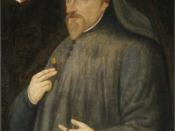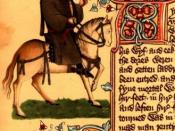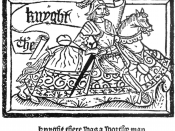The Canterbury Tales tell the story of a group of pilgrims on their way to Canterbury who engage in a tale-telling contest to pass the time. Besides watching the interactions between the characters, we get to read 24 of the tales the pilgrims tell. â¨â¨Geoffrey Chaucer likely wrote The Canterbury Tales in the late 1380s and early 1390s, after his retirement from life as a civil servant. In this professional life, Chaucer was able to travel from his home in England to France and Italy. There, he not only had the chance to read Italian and French literature, but possibly, even to meet Boccaccio, whose Decameron - a collection of tales told by Italian nobility holed up in a country house to escape the plague ravaging their city - may have inspired the frame story of The Canterbury Tales.â¨
Credulous, Ironic
As a narrator, Chaucer shifts between appearing very naïve (i.e.,
inexperienced and way too ready to believe whatever anyone tells him) and approaching his subjects with heavy irony, or knowledge about the difference between the way the pilgrims want to appear and the way they actually are. We see this all-believing, or credulous, tone most often when Chaucer praises pilgrims. For example, in his portrait of the Monk, we learn that the Monk believes that he should let "old things" - like his vows of poverty and chastity - pass. Chaucer tells us, "I seyde his opinioun was good / What should he studie and make hymselven woode?" (General Prologue 183 - 184). Chaucer's easy acceptance of the Monk's excuses here make him appear a little naïve as a narrator, and as a character.
About Geoffrey Chaucer: Geoffrey Chaucer, an English poet, was born in 1342. Historians are uncertain about his exact date of... |


